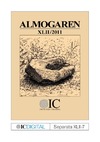Identificador persistente para citar o vincular este elemento:
https://accedacris.ulpgc.es/jspui/handle/10553/58715
| Título: | El hábitat troglodita en Gran Canaria: Evolución del hogar desde tiempos prehispánicos | Autores/as: | Santana Rodríguez, R. Pérez Luzardo, José Manuel Pérez-Luzardo Díaz, Jessica |
Clasificación UNESCO: | 51 Antropología | Palabras clave: | Gran Canaria Troglodytes Caves Social development Rural architecture |
Fecha de publicación: | 2011 | Publicación seriada: | Almogaren | Resumen: | Los núcleos trogloditas representan la arquitectura tradicional rural de más arraigo en Canarias. Es destacable el uso de este hábitat desde periodos prehispánicos y supervivencia en el periodo posconquista. Su valor le sobreviene por el hecho de que lacasa-cueva cuenta con la ventaja de ser una residencia con altas cualidades habitables,que además supone la posibilidad de ejecución sin necesidad de ayudas externas. Latécnica de construcción de la cueva es sumamente elemental, aunque existía mano deobra especializada, en muchas ocasiones, la misma persona que después iba a ocupar lacueva realizaba el trabajo, si no de forma total, sí al menos ayudando en gran parte en elproceso de excavación y adaptación del hueco excavado como vivienda.Gran Canaria es esencial en el conocimiento global de la arquitectura troglodita debido asu carácter de isla volcánica. El momento actual y futuro donde se aprecia el respeto porel patrimonio etnográfico permite recuperar los nexos perdidos con nuestra culturaprehispánica y del norte de África, a la vez que proporcionar las claves de lo que podríaser una arquitectura rural en el futuro con características bioclimáticas inmejorables ysostenibles en cuanto a su ejecución o rehabilitación. Además, todo ello supondría unaóptima adecuación del entorno paisajístico canario. The troglodytic sites represent the most deeply-rooted traditional rural architecture in theCanary Islands. The use of these areas since the Prehispanic times and their survival afterthe Spanish Conquest are remarkable. Its value lies in the fact that the dwelling caveshave the advantage of being a place with top qualities to live in. Furthermore, this type ofdwellings can be built without the need for external help. The techniques for theconstruction of caves are highly rudimentary, although specialised labour did exist at thattime. On many occasions, the cave-dweller would himself/herself perform almost all theconstruction works and would only require help during the excavation and the adaptationof the hole digged for the dwelling.Gran Canaria is essential for the global knowledge of troglodytic architecture, due to thevolcanic nature of the island. It is now and in the future when the respect for theethnographic heritage is and will be appreciated. Thus, it allows us to recover those lost links between our Prehispanic background and the North African culture, as well as toprovide the keys for a future rural architecture with excellent and sustainable bioclimaticfeatures with regard to both construction and refurbishment. Furthermore, all this wouldentail an ideal adaptation of the landscape of the Canary Islands. In der traditionellen ländlichen Architektur des kanarischen Archipels gelten die Höhlen-siedlungen als häufigste Form des Habitats. Hervorzuheben dabei ist die lange Nutzungdieser Wohn- und Siedlungsform, die von der prähispanischen Epoche bis in die Zeitnach der Eroberung der Inselgruppe durch die Kastilische Krone reicht. Dies ist unteranderem auf die Tatsache zurückzuführen, dass die Höhlen zum Wohnen äuerst geeignetwaren und mit geringem Aufwand bewohnbar gemacht werden konnten. Die zum Höhlen-bau verwendete Technik ist äuerst elementar, so dass die späteren Bewohner meist selbstden Ausbau der Höhle mit Unterstützung spezialisierter Arbeitskräfte vornahmen.Auf Grund des vulkanischen Ursprungs Gran Canarias spielt die Insel eine groe Rolle beider allgmeinen Erforschung der Höhlenarchitektur. Das derzeitige Bewusstsein derkanarischen Bevölkerung für ethnographisches Kulturgut fördert die Rückbesinnung aufihre prähispanischen und nordafarikanischen Wurzeln. Dadurch wird ein Ausgangspunktgeschaffen für mögliche künftige Projekte zur Förderung, zum Erhalt und zum Wieder-aufbau der ländlichen Architektur unter Berücksichtigung bioklimatischer Aspekte, öko-logischer Nachhaltigkeit sowie einer optimalen Anpassung an die landschaftlichen Gege-benheiten des Archipels. |
URI: | https://accedacris.ulpgc.es/handle/10553/58715 | ISSN: | 1695-2669 | Fuente: | Almogaren [ISSN 1695-2669] (42), p. 89-108 | URL: | http://dialnet.unirioja.es/servlet/articulo?codigo=3711366 |
| Colección: | Artículos |
Visitas
316
actualizado el 05-oct-2024
Descargas
145
actualizado el 05-oct-2024
Google ScholarTM
Verifica
Comparte
Exporta metadatos
Los elementos en ULPGC accedaCRIS están protegidos por derechos de autor con todos los derechos reservados, a menos que se indique lo contrario.
